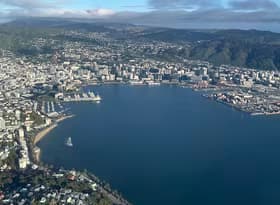
World population to peak earlier, what this means for our migration
The United Nations released its biannual World Population Prospects earlier this month, a global population projection to the year 2100. In this article, we explore the latest projections for the world’s population, and what the trends might mean for New Zealand’s migration.
World’s population projected to peak earlier
The world’s population growth has been slowing ever since the post-World War Two baby boom of the 1960s. Chart 1 shows that population growth peaked at 2.2%pa in 1964, with growth slowing thereafter to 0.9%pa in 2023. As of July 2023, the world’s population is estimated to be 8.2b.
The 2024 World Population Prospects project that the world’s population will grow more slowly than predicted in the 2022 edition, and to peak earlier, in the 2080s. The 2024 projections show a peak population of 10.3b in the mid-2080s, before slipping to 10.2b by 2100. The 2022 edition projected a higher peak of 10.4b in the late 2080s, and a population of 10.3b at the end of the century. According to the 2024 edition, the world’s population is projected to decline by 0.1%pa from 2090 onwards.
The shift towards an earlier population peak has been driven by a combination of factors, most prominently weaker-than-expected fertility rates – more on that later.
Looming shift from Asia to Africa as driver of global growth
Africa has been the world’s fastest growing region since the 1980s, although by 2023 it had only grown to around one third the size of Asia (see Chart 2). Africa’s population is projected to grow from 1.5b today to 3.8b in 2100, accounting for 38% of the world’s population by then. Asia is projected to remain the largest region, home to 4.6b in 2100 and accounting for 45% of the world’s population. However, Asia’s population is projected to decline from the 2050s onwards and, based on these trends, Africa might overtake Asia early next century.
The world’s slowest growing region is Europe, where the population is estimated to have peaked in 2020.
One in four people live in a country which has already peaked
One of the most staggering findings of the 2024 World Population Prospects is that 28% of people, or just over one in four of the world’s population, live in a country that had reached its peak projected population before 2024. These countries include China, Germany, Japan and the Russian Federation, all of which had an estimated total fertility rate under 1.5 births per women in their lifetime in 2023. With China’s population in decline since 2021, Asia’s growth is now being driven by India and Pakistan. New Zealand is subject to the same trend, recently reaching a record low fertility rate of 1.5 in 2024. The global total fertility rate was estimated at 2.3, projected to decline to the minimum replacement rate of 2.1 by 2050.
Countries with an aging and declining population will become increasingly reliant on net migration gain to maintain their workforce. With an increasing number of declining populations, global demand for migrants is likely to become heightened.
What this means for New Zealand
Migration is becoming an increasingly important part of New Zealand’s population growth as our fertility rate continues to fall. By the UN’s medium projection, New Zealand’s deaths will exceed births by 2050, meaning that from that point onwards net migration will be the only thing keeping our population from outright decline. The UN projects New Zealand’s population will peak at 5.9m by 2080, easing to 5.8m by the end of the century. In this sense, the projection for New Zealand is similar to the global average, with New Zealand’s population projected to peak just a few years before the world’s population.
With slowing population growth around the world, we can expect more demand for Kiwis to take their skills overseas, and more competition in attracting migrants to New Zealand, putting downwards pressure on our net migration levels.
Where do our migrants come from?
New Zealand recorded a net migration gain of 521,100 over the 10 years to December 2023, made up of a net loss of 73,600 New Zealand citizens and a net gain of 591,700 non-New Zealand citizens.
Chart 3 shows that out of the 591,700 non-citizen net migrants, 13% were citizens of Oceania – largely our neighbours Australia, Fiji, Tonga, and Samoa. Oceania only represents 0.6% of the world’s population, but it makes sense that our strongest inflows come from our nearest neighbours. Both Australia and the rest of Oceania are projected to continue growing throughout this century, although growth is projected to be patchy across the Pacific Islands.
Asian citizens accounted for 63% of net migration to New Zealand, largely from China, India, and the Philippines. Asia accounts for 59% of the world’s population today, so its share of net migration to New Zealand is broadly proportionate. The populations of India and the Philippines are projected to continue growing throughout this century. However, China’s population is projected to more than halve - from 1.4b in 2024 to 639m in 2100.
Net migration of African citizens accounted for 11% of net migration to New Zealand, mostly from South Africa, which only accounts for 0.8% of the world’s population. Africa accounts for 19% of the world’s population, and that share is projected to grow to 27% in the next 30 years. New Zealand may need to increasingly turn to the rest of Africa for net migration, especially as population growth slows or even turns negative in our key migration sources of China, India, and the Philippines.
Shifts in population will change economies, trade, and politics
Slowing and uneven population growth has huge implications for the global economy. Slower population growth means weaker economic growth, as slower population means less growth in demand, as well as slower growth of the labour force. Global leadership may shift, as historically leading countries face slower or declining population growth.
Putting aside the immigration implications for New Zealand, what really matters to us as a small trading nation is where the wealthy populations of the world are – with the UN World Population Prospects filling half of that picture. The implications for relative incomes, as Asian and African economies continue to develop are less clear. But the weight of population numbers suggests that Africa and parts of Asia offer much more potential for New Zealand export growth over the long term.
















